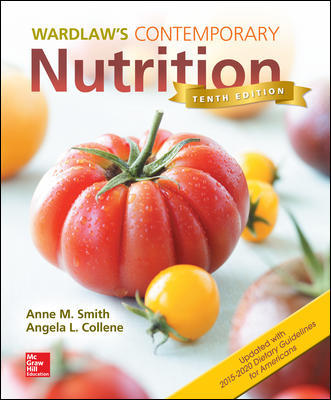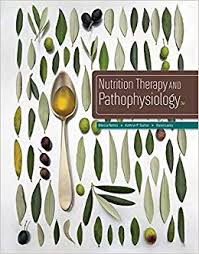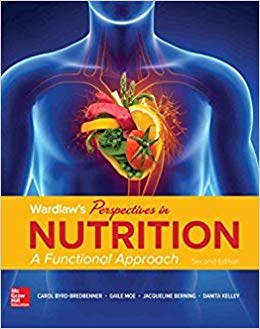Wardlaws Contemporary Nutrition Updated with 2015 2020 10th Edition Dietary Guidelines for Americans – Test Bank
Original price was: $55.00.$25.00Current price is: $25.00.
Digital item No Waiting Time Instant Download
ISBN-13:9781259918346 ISBN:1259918346
Authors:Gordon M. Wardlaw,Angela Collene,
Anne Smith,Anne M. Smith
Publisher : McGraw Hill
Description
Wardlaws Contemporary Nutrition Updated with 2015 2020 Dietary Guidelines for Americans – Test Bank
Chapter 01 Nutrition, Food Choices, and Health
Multiple Choice Questions
1. Recent surveys indicate that the most commonly purchased foods in America are
A. pizza, soft drinks, cheesburgers, and French fries.
B. milk, ready-to-eat cereal, bottled water, soft drinks, and bread.
C. tacos, bagels, bottled water, and ice cream.
D. fried chicken, ribs, beer, and donuts.
Blooms Level: 1. Remember
Learning Outcome: 01.06 List the major characteristics of the North American diet, the food habits that often need improvement, and the key “Nutrition and Weight Status” objectives of the Healthy People 2020 report.
Section: 01.01 Why Do You Choose the Food You Eat?
Topic: Demographic trends and statistics
2. Which of the following is not a class of essential nutrients?
A. Alcohol
B. Carbohydrates
C. Lipids
D. Minerals
Blooms Level: 2. Understand
Learning Outcome: 01.03 Define the terms nutrition, carbohydrate, protein, lipid (fat), alcohol, vitamin, mineral, water, phytochemical, kilocalorie (kcal), and fiber.
Section: 01.03 What Are the Classes and Sources of Nutrients?
Topic: Nutrition basics
3.
Which of the following is the leading nutrition-related cause of death in the United States?
A. Diabetes
B.
Pneumonia
C.
Heart disease
D. Cancer
Blooms Level: 1. Remember
Learning Outcome: 01.02 Identify diet and lifestyle factors that contribute to the 15 leading causes of death in North America.
Section: 01.02 How Is Nutrition Connected to Good Health?
Topic: Demographic trends and statistics
4. Which of the following nutrients can directly supply energy for human use?
A. Lipids and oils
B. Fiber
C. Vitamins
D. Minerals
Blooms Level: 1. Remember
Learning Outcome: 01.04 Determine the total calories (kcal) of a food or diet using the weight and calorie content of the energy-yielding nutrients, convert English to metric units, and calculate percentages, such as percent of calories from fat in a diet.
Section: 01.04 What Math Concepts Will Aid Your Study of Nutrition?
Topic: Nutrition basics
5. Certain nutrients provide us with energy. Some are important for growth and development. Others act to keep body functions running smoothly. Which of the following nutrients does not promote growth and development as its primary function?
A. Lipids
B. Carbohydrates
C. Proteins
D. Minerals
Blooms Level: 1. Remember
Learning Outcome: 01.03 Define the terms nutrition, carbohydrate, protein, lipid (fat), alcohol, vitamin, mineral, water, phytochemical, kilocalorie (kcal), and fiber.
Section: 01.03 What Are the Classes and Sources of Nutrients?
Topic: Nutrition basics
6. What substances, present in fruits and vegetables, provide significant health benefits such as reducing the risk of cancer?
A. Phytochemicals
B. Beta blockers
C. Deoxidizers
D. Free radicals
Blooms Level: 1. Remember
Learning Outcome: 01.03 Define the terms nutrition, carbohydrate, protein, lipid (fat), alcohol, vitamin, mineral, water, phytochemical, kilocalorie (kcal), and fiber.
Section: 01.03 What Are the Classes and Sources of Nutrients?
Topic: Phytochemicals
7. The essential nutrients
A. must be consumed at every meal.
B. are required for infants but not adults.
C. can be made in the body when they are needed.
D. cannot be made by the body and therefore must be consumed to maintain health.
Blooms Level: 1. Remember
Learning Outcome: 01.03 Define the terms nutrition, carbohydrate, protein, lipid (fat), alcohol, vitamin, mineral, water, phytochemical, kilocalorie (kcal), and fiber.
Section: 01.02 How Is Nutrition Connected to Good Health?
Topic: Nutrition basics
8. The Food and Nutrition Board (FNB) of the National Academy of Sciences advocates that 10% to 35% of calories come from protein and ________________ from carbohydrate.
A. 20% to 35%
B. 45% to 65%
C. 50% to 70%
D. 55% to 75%
Blooms Level: 1. Remember
Learning Outcome: 01.06 List the major characteristics of the North American diet, the food habits that often need improvement, and the key “Nutrition and Weight Status” objectives of the Healthy People 2020 report.
Section: 01.06 What Is the Current State of the North American Diet and Health?
Topic: Nutrition basics
9. Fibers belong to the class of nutrients known as
A. carbohydrates.
B. protein.
C. lipids.
D. minerals.
Blooms Level: 2. Understand
Learning Outcome: 01.03 Define the terms nutrition, carbohydrate, protein, lipid (fat), alcohol, vitamin, mineral, water, phytochemical, kilocalorie (kcal), and fiber.
Section: 01.03 What Are the Classes and Sources of Nutrients?
Topic: Nutrition basics
10. Which of the following is a characteristic of vitamins?
A. Provide energy
B. Become structural components of the body
C. Enable chemical processes in the body
D. Made in sufficient quantities by the body
Blooms Level: 1. Remember
Learning Outcome: 01.03 Define the terms nutrition, carbohydrate, protein, lipid (fat), alcohol, vitamin, mineral, water, phytochemical, kilocalorie (kcal), and fiber.
Section: 01.03 What Are the Classes and Sources of Nutrients?
Topic: Nutrition basics
11. Minerals can
A. provide energy.
B. be destroyed during cooking.
C. be degraded by the body.
D. become part of the body structural systems.
Blooms Level: 1. Remember
Learning Outcome: 01.03 Define the terms nutrition, carbohydrate, protein, lipid (fat), alcohol, vitamin, mineral, water, phytochemical, kilocalorie (kcal), and fiber.
Section: 01.03 What Are the Classes and Sources of Nutrients?
Topic: Nutrition basics
12. Which of the following is not a characteristic of carbohydrates?
A. Contain more kilocalories than protein
B. Supply 4 kilocalories per gram
C. Add sweetness to food
D. Provide a major source of fuel for the body
Blooms Level: 1. Remember
Learning Outcome: 01.03 Define the terms nutrition, carbohydrate, protein, lipid (fat), alcohol, vitamin, mineral, water, phytochemical, kilocalorie (kcal), and fiber.
Section: 01.03 What Are the Classes and Sources of Nutrients?
Topic: Nutrition basics
13. Which of the following is characteristic of lipids?
A. Supply 4 kilocalories per gram
B. Add structural strength to bones and muscles
C. Supply a concentrated form of fuel for the body
D. Add sweetness to food
Blooms Level: 1. Remember
Learning Outcome: 01.03 Define the terms nutrition, carbohydrate, protein, lipid (fat), alcohol, vitamin, mineral, water, phytochemical, kilocalorie (kcal), and fiber.
Section: 01.03 What Are the Classes and Sources of Nutrients?
Topic: Nutrition basics
14. A warning sign or symptom of alcohol poisoning is
A. semiconsciousness or unconsciousness.
B. rapid breathing.
C. skin that is hot to the touch.
D. insomnia.
Blooms Level: 2. Understand
Learning Outcome: 01.08 Identify food and nutrition issues relevant to college students.
Section: Nutrition and Your Health
Topic: Nutrition basics
15. Gram for gram, which provides the most energy?
A. Carbohydrates
B. Proteins
C. Alcohol
D. Fats
Blooms Level: 2. Understand
Learning Outcome: 01.04 Determine the total calories (kcal) of a food or diet using the weight and calorie content of the energy-yielding nutrients, convert English to metric units, and calculate percentages, such as percent of calories from fat in a diet.
Section: 01.04 What Math Concepts Will Aid Your Study of Nutrition?
Topic: Nutrition basics
16. Which of the following is not a characteristic of protein?
A. Major component of body structure
B. Supplies 4 kilocalories per gram
C. Most significant energy source for humans
D. Forms enzymes
Blooms Level: 1. Remember
Learning Outcome: 01.03 Define the terms nutrition, carbohydrate, protein, lipid (fat), alcohol, vitamin, mineral, water, phytochemical, kilocalorie (kcal), and fiber.
Section: 01.03 What Are the Classes and Sources of Nutrients?
Topic: Nutrition basics
17. Which of the following yield greater than 4 kilocalories per gram?
A. Plant fats
B. Plant carbohydrates
C. Plant proteins
D. Animal proteins
Blooms Level: 2. Understand
Learning Outcome: 01.04 Determine the total calories (kcal) of a food or diet using the weight and calorie content of the energy-yielding nutrients, convert English to metric units, and calculate percentages, such as percent of calories from fat in a diet.
Section: 01.04 What Math Concepts Will Aid Your Study of Nutrition?
Topic: Nutrition basics
18. Which of the following is not true about water?
A. Provides energy
B. Provides a way to transport nutrients and wastes
C. By-product of cell chemical reactions
D. Dietary need of approximately 9-13 cups per day
Blooms Level: 1. Remember
Learning Outcome: 01.03 Define the terms nutrition, carbohydrate, protein, lipid (fat), alcohol, vitamin, mineral, water, phytochemical, kilocalorie (kcal), and fiber.
Section: 01.03 What Are the Classes and Sources of Nutrients?
Topic: Nutrition basics
19. Which of the following is true about the energy content of nutrients?
A. Lipids supply 7 kilocalories per gram.
B. Carbohydrates and proteins supply 4 kilocalories per gram.
C. Alcohol supplies 9 kilocalories per gram.
D. Lipids and alcohol supply 9 kilocalories per gram.
Blooms Level: 1. Remember
Learning Outcome: 01.04 Determine the total calories (kcal) of a food or diet using the weight and calorie content of the energy-yielding nutrients, convert English to metric units, and calculate percentages, such as percent of calories from fat in a diet.
Section: 01.04 What Math Concepts Will Aid Your Study of Nutrition?
Topic: Nutrition basics
20. A kilocalorie is a measure of
A. heat energy.
B. fat in food.
C. nutrients in food.
D. sugar and fat in food.
Blooms Level: 1. Remember
Learning Outcome: 01.04 Determine the total calories (kcal) of a food or diet using the weight and calorie content of the energy-yielding nutrients, convert English to metric units, and calculate percentages, such as percent of calories from fat in a diet.
Section: 01.04 What Math Concepts Will Aid Your Study of Nutrition?
Topic: Nutrition basics





Be the first to review “Wardlaws Contemporary Nutrition Updated with 2015 2020 10th Edition Dietary Guidelines for Americans – Test Bank”